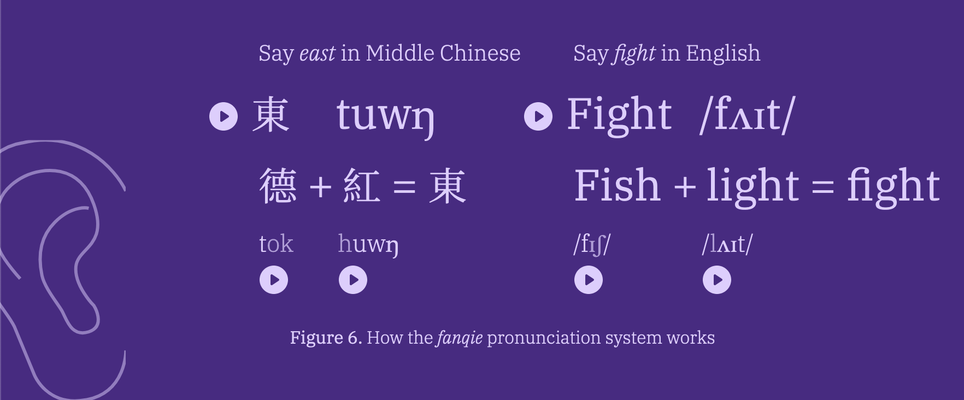Announcing Startwords Issue 4

Startwords Issue 4 includes visuals and brief audio clips to demonstrate a medieval Chinese system for indicating the pronunciation of words. Designed by Gissoo Doroudian and Nick Budak, included in “Of Sonorous Medieval Chinese Texts and NLP Model Training.”
The Center for Digital Humanities (CDH) is excited to announce the publication of Startwords Issue 4: PALIMPSESTS. Startwords is a research periodical irregularly published by the CDH and a forum for experimental research in the humanities. Issue 4 showcases the work of leading researchers in East Asian digital humanities who are using data and computation to think through, mirror, and recreate scholarly practices from the ancient past.
As Anna M. Shields (Gordon Wu ‘58 Professor of Chinese Studies; Professor of East Asian Studies; Chair, Department of East Asian Studies, Princeton) writes in the issue introduction, each of these articles uniquely demonstrates “the ways that a sustained engagement with ancient forms of knowledge making can challenge us to rethink the predominant modes of understanding text and space in fields like data science and digital humanities.”
![sonorous-medieval-fig7 Screenshot of a table of Chinese text with English translations beneath. The Chinese characters are underlined with different color-coded line shapes indicating the different types of annotations indicated by the text. The English translation reads: “Edition[s] also write it [摩] as “磨”. It is pronounced like 末 + 何 [ma]. Jing says that it means ‘milled against one another.’ ‘Mill’ [磑] is pronounced like 古 + 代 [gojH]. Ma says that it means ‘ground up.’ Zheng's commentary on the Book of Rites says that it means ‘compelled.’”](/media/images/annotation-chart_D8JxiNO.max-964x1051_f3HKG2B.png)
A figure showing the variety of different types of annotations in the seventh-century Jingdian Shiwen 經典釋文, including notes on the semantic, phonetic, graphic, and citational qualities of the text. Designed by Gissoo Doroudian and Nick Budak, included in “Of Sonorous Medieval Chinese Texts and NLP Model Training.”
In this issue:
- Nick Budak (Software Developer, Library Technology, Stanford Libraries) and Gian Rominger (Assistant Professor, Asian Languages & Literature, University of Washington) detail their natural language processing (NLP) work with the Chinese scholar Lu Deming’s (556–630 CE) Jingdian Shiwen 經典釋文. In a project supported by the CDH’s NEH-funded New Languages for NLP workshops, Budak and Rominger operationalize this fifteen-hundred-year-old text as a form of semi-structured data. “Deming’s meticulous attention to detail,” they write, “produced what is effectively a machine-readable dataset millennia before such machines would exist.”
- Xin Wen (Assistant Professor of East Asian Studies, Princeton University) shares a snapshot of his work in progress, supported by a CDH Data Fellowship: an interactive, deep map that reveals the many ancient layers grounding the city of Chang’an (modern-day Xi’an). In planning for a digital map that can account for “the geographical dimensions of historical change,” Wen describes the diversity of his data sources, including ninth-century fictional narratives plotted in the streets, eleventh-century stone maps, seventeenth-century gazetteers, and contemporary archaeological excavations.
- In addition to introducing the issue, Anna Shields provides a dispatch from last summer’s international East Asian digital humanities conference, “Tools of the Trade: The Way Forward.” She describes the challenges and opportunities of working across multiple languages, historical periods, and technologies.
With this issue, Startwords celebrates its third anniversary. The journal launched in October 2020 with a mission to create a space for experimental, computational, and data-driven research in the humanities, showcased through an essayistic writing style that is approachable to a general readership. Issue 1: TRANSFORMATIONS first demonstrated this approach with a range of capabilities like embedded 3D objects, high-definition IIIF images, articles generated in multiple formats (HTML, PDF, TXT), custom designs for pull quotes, and a unique solution to viewing endnotes in context that we call contextual notes. The code for the website — built using the static site generator Hugo — is available under an open-source license on GitHub.
Since its launch, research published in Startwords has been cited by books, journal articles, course syllabi, and popular newsletters. We have showcased voices that include prominent senior scholars, nonprofit software engineers, graduate students, and librarians. And with each new issue, the CDH has been busy building new affordances into the journal. Issue 2: SCRIBES, allowed for “interludes” in the article text containing executable code, social media posts, and embedded videos. With Issue 3: PARROTS, the CDH implemented multilingual support so that each article can be published in multiple languages.
Issue 4: PALIMPSESTS finds us continuing to formalize and refine the hand-off between overlapping workflows for writing, editing, design, and development, each with its own (often conflicting!) terminologies and timelines. The new issue also includes handling for Chinese character sets, a revamped PDF production pipeline using DocRaptor, and custom designs for figures like the ones pictured above; designer Gissoo Doroudian worked from drafts sketched by author (and former CDH Developer) Nick Budak in order to devise a visual language for highlighting all of the many different ways that a medieval Chinese text can contain information.
While we are not accepting submissions for future issues, we welcome your thoughts and feedback on any aspect of the project. We would especially love to hear from those of you who have used Startwords in your research or teaching. Please contact us via email at cdh-info@princeton.edu with the subject “Startwords.”